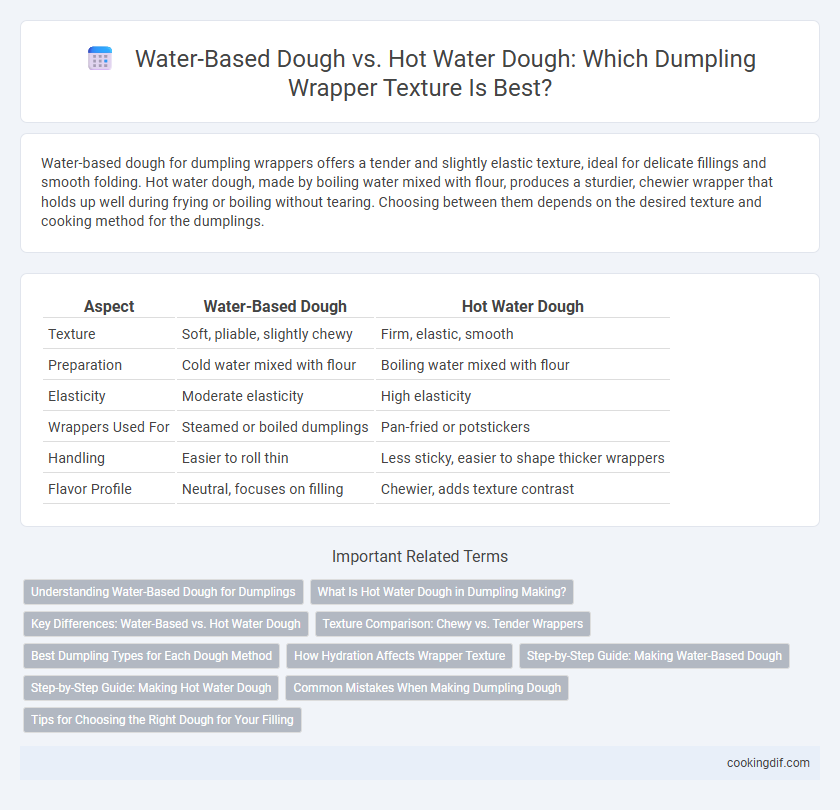Water-based dough for dumpling wrappers offers a tender and slightly elastic texture, ideal for delicate fillings and smooth folding. Hot water dough, made by boiling water mixed with flour, produces a sturdier, chewier wrapper that holds up well during frying or boiling without tearing. Choosing between them depends on the desired texture and cooking method for the dumplings.
Table of Comparison
| Aspect | Water-Based Dough | Hot Water Dough |
|---|---|---|
| Texture | Soft, pliable, slightly chewy | Firm, elastic, smooth |
| Preparation | Cold water mixed with flour | Boiling water mixed with flour |
| Elasticity | Moderate elasticity | High elasticity |
| Wrappers Used For | Steamed or boiled dumplings | Pan-fried or potstickers |
| Handling | Easier to roll thin | Less sticky, easier to shape thicker wrappers |
| Flavor Profile | Neutral, focuses on filling | Chewier, adds texture contrast |
Understanding Water-Based Dough for Dumplings
Water-based dough for dumpling wrappers offers a tender, slightly chewy texture due to its higher moisture content, which enhances pliability and ease of folding. This dough is typically made with cold or room-temperature water to maintain dough elasticity, resulting in smoother, more delicate wrappers ideal for steamed or boiled dumplings. Compared to hot water dough, which yields a firmer, more resilient wrapper suited for pan-fried dumplings, water-based dough prioritizes softness and subtle texture perfect for retaining juicy fillings.
What Is Hot Water Dough in Dumpling Making?
Hot water dough in dumpling making is a type of dough prepared by mixing boiling water with flour, resulting in a soft yet elastic wrapper texture ideal for dumplings. This method gelatinizes the starches in the flour, producing a dough that is more pliable and chewy compared to traditional water-based dough. Hot water dough enhances the structural integrity of dumpling wrappers, allowing them to hold fillings securely while providing a tender bite.
Key Differences: Water-Based vs. Hot Water Dough
Water-based dough for dumpling wrappers typically produces a tender and slightly chewy texture due to its higher hydration level, making it ideal for delicate fillings. Hot water dough, prepared by boiling water into the flour, results in a smooth, pliable, and elastic wrapper that resists tearing during cooking, often preferred for thicker or steamed dumplings. The key difference lies in hydration method: cold water yields a softer texture, while hot water enhances elasticity and strength in the dough.
Texture Comparison: Chewy vs. Tender Wrappers
Water-based dough creates dumpling wrappers with a tender and delicate texture, ideal for light and soft fillings, while hot water dough yields a chewier and more elastic wrapper, providing a sturdy and satisfying bite. The higher gelatinization of starch in hot water dough enhances the chewiness, making it perfect for thicker or meat-filled dumplings. Choosing between these dough types depends on the desired mouthfeel and filling robustness for the dumpling experience.
Best Dumpling Types for Each Dough Method
Water-based dough creates a soft, tender wrapper ideal for delicate dumplings like wontons or jiaozi, which benefit from a smooth, pliable texture that seals fillings effectively. Hot water dough, with its chewier, slightly elastic consistency, works best for heartier dumplings such as potstickers or baozi, providing a resilient wrapper that holds up well to pan-frying or steaming. The choice between water-based and hot water dough directly impacts the dumpling's mouthfeel, cooking method suitability, and overall dining experience.
How Hydration Affects Wrapper Texture
Water-based dough for dumpling wrappers creates a tender and pliable texture due to higher hydration levels, allowing gluten to develop more evenly. Hot water dough, made by mixing boiling water into flour, results in a chewier and slightly denser wrapper because the heat partially cooks the starches, reducing elasticity. Optimal hydration balances softness and strength, ensuring dumpling wrappers maintain integrity during cooking while delivering the desired mouthfeel.
Step-by-Step Guide: Making Water-Based Dough
Water-based dough for dumpling wrappers offers a tender and slightly chewy texture, achieved by mixing cold water with flour to form a smooth, elastic dough. Begin by gradually adding cold water to all-purpose flour while stirring continuously, then knead the dough thoroughly for 8-10 minutes to develop gluten strength. Rest the dough for at least 30 minutes under a damp cloth to relax the gluten, ensuring an easier rolling process and a soft yet resilient wrapper ideal for various fillings.
Step-by-Step Guide: Making Hot Water Dough
Hot water dough, made by boiling water added to flour, creates a pliable yet firm dumpling wrapper with a smooth texture ideal for pan-fried and steamed dumplings. To make hot water dough, heat water until boiling, gradually pour over flour while stirring, then knead vigorously until a soft, elastic dough forms, allowing it to rest covered for 30 minutes. This method results in wrappers that hold shape well during cooking, offering a tender bite distinct from the slightly chewy texture of cold water dough.
Common Mistakes When Making Dumpling Dough
Using water-based dough often leads to wrappers that are too soft and prone to tearing, while hot water dough creates a chewier, more elastic texture ideal for dumplings. A common mistake is overworking water-based dough, which can result in tough wrappers, whereas insufficient kneading of hot water dough prevents proper gluten development, causing dough to be sticky and hard to shape. Balancing hydration and kneading time is crucial to achieve the desired wrapper texture and avoid these frequent errors.
Tips for Choosing the Right Dough for Your Filling
Water-based dough offers a lighter, smoother wrapper ideal for delicate fillings like shrimp or vegetables, enhancing their natural flavors without overpowering them. Hot water dough produces a chewier, more elastic wrapper that holds up well to meat-heavy or juicy fillings, preventing breaks during cooking. Match your dough texture to the moisture and density of the filling to achieve the perfect balance between wrapper strength and tenderness.
Water-based dough vs Hot water dough for wrapper texture Infographic

 cookingdif.com
cookingdif.com